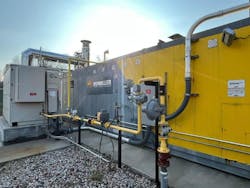Brenmiller Installs Thermal Energy Storage at SUNY Purchase College Campus
The State University of New York's (SUNY) Purchase College will start the new year taking control of a thermal energy storage system built on campus by Brenmiller Energy.
The bGen thermal energy storage-based co-generation system (TES) was completed by Brenmiller and developed in partnership with the New York Power Authority. Using exhaust gas and electricity from an on-site combined heat and power microturbine, the bGen TES is expected to eliminate close to 550 metric tons of greenhouse gas (GHG) emissions annually compared to previous power pollution output.
Israel-based Brenmiller is turning over operation of the system to SUNY’s campus in Purchase, New York by mid-January.
“Turning over the operation of the first bGen system in the United States is a huge milestone for Brenmiller,” company CEO Avi Brenmiller said in a statement. “We’ve had a highly productive and rewarding experience working in collaboration with the New York Power Authority and SUNY.”
The company’s bGen technology stores energy, from both excess heat and electricity, in crushed rocks and can deliver steam or hot air on demand, according to the Brenmiller website. The TES units have been utilized in other projects globally, including at a plastics manufacturing plant in Brazil.
The SUNY project was financed partially by a grant from the Israel-U.S. Binational Industrial Research and Development Foundation. Brenmiller’s bGen Zero technology was recently highlighted by TIME magazine as one of the 200 best inventions of 2023.
When the project was originally announced in 2017, among the partners named were Brenmiller, NYPA, and Capstone Turbine Corp.
According to a study commissioned by the Renewable Thermal Collaborative, a scaling up for thermal battery deployment nationwide would eliminate almost 800 million metric tons of GHG emissions per year.
About the Author
Rod Walton, EnergyTech Managing Editor
Managing Editor
For EnergyTech editorial inquiries, please contact Managing Editor Rod Walton at [email protected].
Rod Walton has spent 17 years covering the energy industry as a newspaper and trade journalist. He formerly was energy writer and business editor at the Tulsa World. Later, he spent six years covering the electricity power sector for Pennwell and Clarion Events. He joined Endeavor and EnergyTech in November 2021.
Walton earned his Bachelors degree in journalism from the University of Oklahoma. His career stops include the Moore American, Bartlesville Examiner-Enterprise, Wagoner Tribune and Tulsa World.
EnergyTech is focused on the mission critical and large-scale energy users and their sustainability and resiliency goals. These include the commercial and industrial sectors, as well as the military, universities, data centers and microgrids. The C&I sectors together account for close to 30 percent of greenhouse gas emissions in the U.S.
He was named Managing Editor for Microgrid Knowledge and EnergyTech starting July 1, 2023
Many large-scale energy users such as Fortune 500 companies, and mission-critical users such as military bases, universities, healthcare facilities, public safety and data centers, shifting their energy priorities to reach net-zero carbon goals within the coming decades. These include plans for renewable energy power purchase agreements, but also on-site resiliency projects such as microgrids, combined heat and power, rooftop solar, energy storage, digitalization and building efficiency upgrades.

